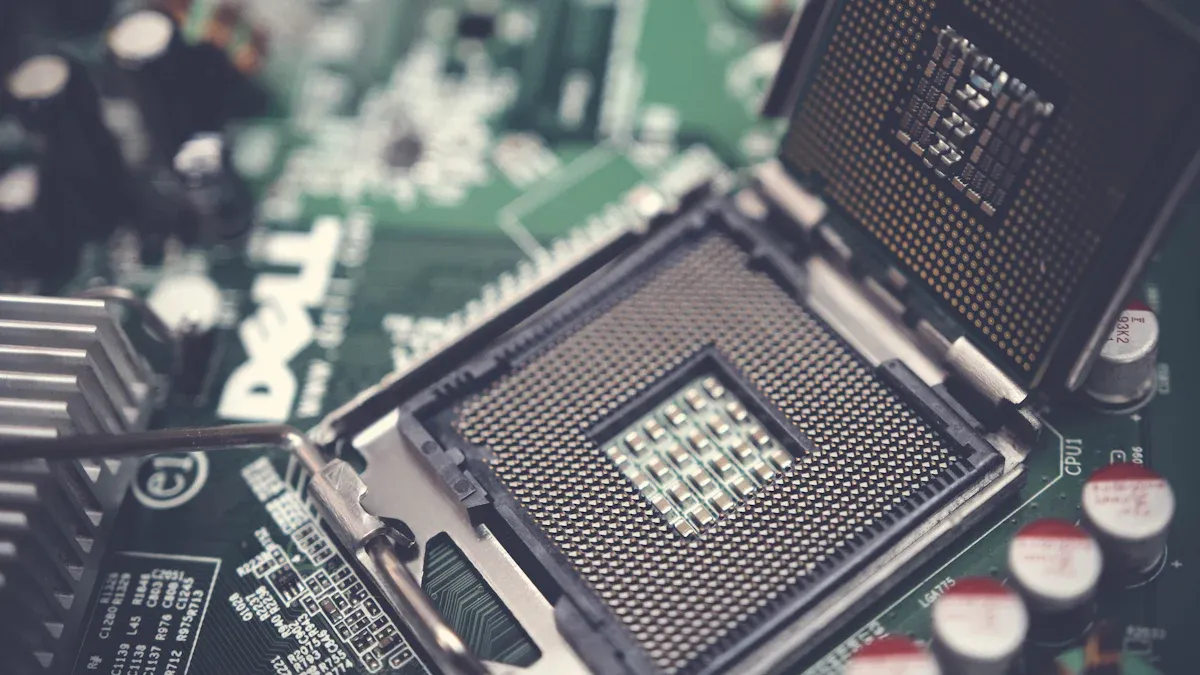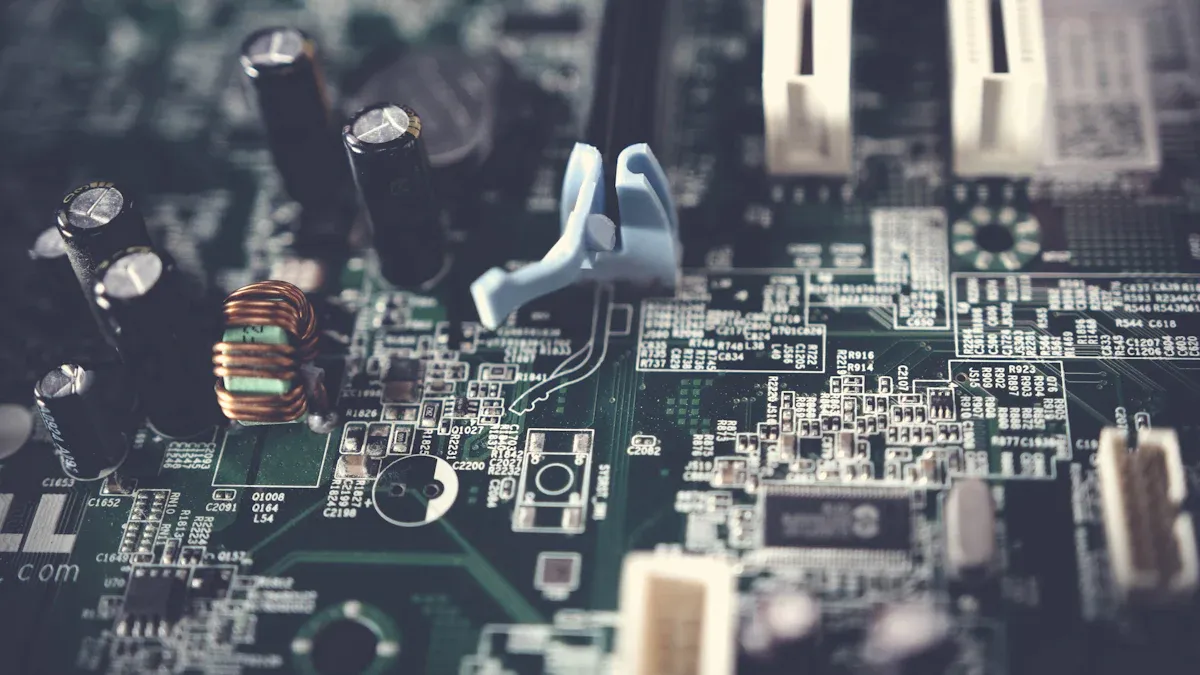
Silicon carbide coating on graphite is essential in semiconductor manufacturing, offering exceptional durability and resistance to extreme temperatures and chemical exposure. A graphite susceptor with silicon carbide significantly enhances performance and reliability in high-temperature applications. EU manufacturers have observed up to a 20% increase in the lifespan of high-temperature equipment due to the use of SiC coating. The growing demand for better semiconductors underscores the importance of silicon carbide plating in advancing industries such as electronics and electric vehicles.
Key Takeaways
- SiC coating helps semiconductors work better by spreading heat well. This lets devices run smoothly even when it’s very hot.
- SiC coating does not react with chemicals. It keeps delicate parts safe from damage, making them last longer and work reliably.
- Using SiC coating saves money. It lowers repair costs and uses less energy, which is great for manufacturers.
Key Properties of SiC Coating

High thermal conductivity for efficient heat dissipation
Efficient heat dissipation is critical in semiconductor manufacturing, where components often operate under extreme temperatures. SiC coating stands out due to its remarkable thermal conductivity. This property ensures that heat generated during high-power applications is quickly and effectively dispersed.
- SiC combined with graphene can reduce thermal resistance by up to 30%. This improvement significantly enhances heat dissipation, even in the most demanding conditions.
- Its ability to withstand high temperatures while maintaining performance makes it ideal for industrial applications requiring heat resistance and corrosion protection.
By improving thermal management, SiC coating helps semiconductor devices maintain stability and efficiency, even in high-temperature environments.
Chemical inertness for protection against corrosive environments
Semiconductor manufacturing involves exposure to harsh chemicals during processes like etching and deposition. SiC coating provides a robust barrier against these corrosive substances. Its chemical inertness ensures that sensitive components remain protected, extending their operational life.
This protective quality is especially valuable in plasma etching systems, where materials are subjected to aggressive chemical reactions. SiC coating acts as a shield, preventing damage and maintaining the integrity of the equipment.
Exceptional durability for long-term reliability
Durability is another key strength of SiC coating. It enhances the lifespan of semiconductor components, reducing the need for frequent replacements. This durability is particularly important in high-power applications, where devices must operate at temperatures exceeding 300°C.
- SiC coatings resist wear and corrosion, ensuring that components remain reliable over time.
- Their longevity also lowers long-term costs, making them a cost-effective choice for industries that demand reliability.
With its exceptional durability, SiC coating supports the production of high-performance semiconductor devices that can withstand the test of time.
Advantages of SiC Coating Over Other Materials
Superior performance compared to quartz and alumina
SiC coating offers unmatched performance when compared to traditional materials like quartz and alumina. Its ability to handle extreme temperatures, often exceeding 300°C, makes it a preferred choice for high-power applications. Unlike quartz, which can crack under thermal stress, or alumina, which may degrade over time, SiC coating remains stable and reliable.
This stability also reduces the need for extensive cooling systems. By improving thermal management, SiC-coated components can cut energy consumption by up to 30%. This makes them not only more efficient but also more environmentally friendly. For industries like aerospace and automotive, where performance under extreme conditions is critical, SiC coating proves to be a game-changer.
Cost-effectiveness through extended component lifespan
The durability of SiC coating translates directly into cost savings. Its ability to enhance the lifespan of semiconductor components reduces the frequency of replacements. This is particularly beneficial in industries where downtime can be costly.
SiC coating also improves thermal conductivity, allowing devices to operate at higher temperatures without compromising performance. This reduces the need for additional cooling equipment, leading to operational cost savings. While the initial investment in SiC technology may be higher, manufacturers often see a quick return on investment. In fact, energy and maintenance savings can result in payback periods as short as two years.
Enhanced reliability in extreme manufacturing conditions
SiC coating excels in extreme manufacturing environments. It protects components from oxidation and thermal degradation, ensuring long-term reliability. In high-temperature applications, such as aerospace turbine engines, SiC-coated parts have shown a lifespan extension of 15-20%.
Its integration with advanced materials like graphene further enhances performance. By reducing thermal resistance by up to 30%, SiC coating ensures efficient heat dissipation even in high-frequency operations. This makes it an essential material for industries that demand durability and precision under challenging conditions.
Practical Applications of SiC Coating in Semiconductor Manufacturing

Role in wafer processing and handling equipment
Wafer processing and handling equipment face constant exposure to high temperatures and abrasive conditions. SiC coating plays a vital role in protecting these components. Its thermal stability ensures that equipment can operate efficiently without overheating. Additionally, the coating’s durability minimizes wear and tear, reducing the need for frequent maintenance.
In wafer handling systems, precision is critical. SiC coating provides a smooth, wear-resistant surface that prevents contamination and ensures accurate wafer positioning. This reliability is essential for maintaining the quality of semiconductor devices during production.
Applications in plasma etching and deposition systems
Plasma etching and deposition systems are at the heart of semiconductor manufacturing. These processes involve harsh chemical reactions that can degrade unprotected components. SiC coating acts as a robust shield, resisting chemical corrosion and maintaining the integrity of the equipment.
For instance, in plasma etching chambers, SiC-coated parts withstand aggressive plasma environments, ensuring consistent performance over time. This protection not only extends the lifespan of the equipment but also enhances the precision of the etching process, leading to higher-quality semiconductor products.
Contribution to high-performance thermal management solutions
Effective thermal management is crucial in semiconductor tools, especially in high-power applications like electric vehicles and renewable energy systems. SiC coatings significantly enhance thermal conductivity, allowing devices to operate at temperatures exceeding 300°C. This capability ensures that heat is efficiently dissipated, preventing overheating and maintaining device stability.
Aerospace turbine engines and nuclear reactor components also benefit from SiC coatings. These coatings improve durability and thermal management, reducing maintenance costs and downtime. The table below highlights some key improvements brought by SiC coating in various applications:
| Application Area | Improvement Description | Lifespan Extension | Cost Reduction |
|---|---|---|---|
| Aerospace turbine engines | SiC coatings protect against oxidation and thermal degradation. | 15-20% | Reduced maintenance costs and downtime. |
| Nuclear reactor components | Enhanced durability and thermal management. | N/A | N/A |
By improving heat dissipation and durability, SiC coating supports the development of reliable, high-performance semiconductor tools.
SiC coating plays a vital role in semiconductor manufacturing. Its unmatched thermal conductivity, chemical resistance, and durability make it indispensable. These qualities ensure reliable, high-performance components. As technology advances, SiC coating will continue driving innovation, helping industries meet growing demands for efficiency and precision.
FAQ
1. Why is SiC coating preferred in semiconductor manufacturing?
SiC coating offers unmatched thermal conductivity, chemical resistance, and durability. These properties make it ideal for handling extreme conditions in semiconductor production.
2. Can SiC coating improve equipment lifespan?
Yes! SiC coating significantly extends the lifespan of semiconductor components by protecting them from wear, corrosion, and thermal stress.
3. Is SiC coating cost-effective for manufacturers?
Absolutely. Its durability reduces maintenance and replacement costs, while improved thermal management lowers energy consumption, making it a smart investment for long-term savings.
💡 Tip: SiC coating isn’t just cost-effective—it’s also a game-changer for industries like electric vehicles and renewable energy!